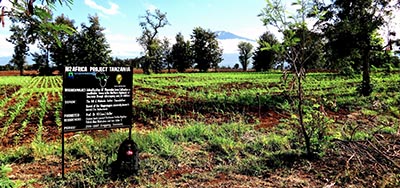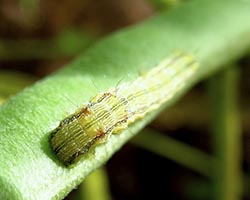 |
Nikolaj M. Vendelbo |
In the horizon behind my field site the snowy-white roof of Africa rises from a dry, khaki-colored landscape. Quite a view, just having left behind the cold weather of the Netherlands to conduct the final part of my MSc degree at Wageningen University: an internship project at N2Africa in the Northern Highlands of Tanzania (March to September, 2017). The objective of my project was to assess the effect of cropping system design on severity in two cultivars of common bean (Phaseolus vulgaris), local Mkanamna and improved Lyamungu, and maize (Zea mays) in Northern Tanzania.
My name is Nikolaj Meisner Vendelbo, BSc. Agrobiology and specialized in Plant Production at Aarhus University (DK, 2012-2015), MSc. Plant Sciences and specialized in Plant pathology and Entomology at Wageningen University & Research (NL, 2015-2017).
| In the field pests and diseases were identified and the most important ones were scored for incidence and severity of their damage to beans and maize throughout the growth season in accordance to protocols obtained from literature. Moreover, plant phenological development – that is leaf setting (vegetative) and setting of reproductive organs – was tracked and the fraction of light intercepted by the crops was measured. At crop maturity, when biotic stresses to the crops declined, I travelled to Dar es Salaam to conduct a laboratory diagnosis. The objective was to verify the field diagnosis of diseases in particularly Common bean with focus on identifying the causative agent of observed root rot, and the distribution throughout the field. |

on Common bean (Phaseolus vulgaris) pod |
At the site I observed no less than 20 pests and 14 diseases, of which the most important included spottet stem borer, African bollworm, common rust and eyespot in maize and various foliage and pod feeders, Alternaria leaf spot and Rhizoctonia root rot in the common bean crop. These stresses, accompanied by ubiquitous symptoms of nutrient deficiencies, were observed to cause substantial yield losses on the site. In maize the yield gap was found to be 64 to 86 percent. Maize intercropped with the local common bean cultivar resulted in the highest achieved land equivalent ratio of 1.64: a yield that is 64% higher than that of the two crops cultivated separately. Overall, the maize-local common bean cropping system performed best for the assessed parameters. Initial statistical analysis did not reveal significant effects of cropping systems on occurrence of biotic stresses, and this is likely influenced by the small plot sizes (5 x 3.2m). As expected these findings underline the necessity of taking into accout biotic stresses in N2Africa research and to disseminate knowledge to smallholder farmers about means to identify the most important biotic stresses mentioned above, and about the means to control them.
Nikolaj Meisner Vendelbo. Click here for the internship report.

